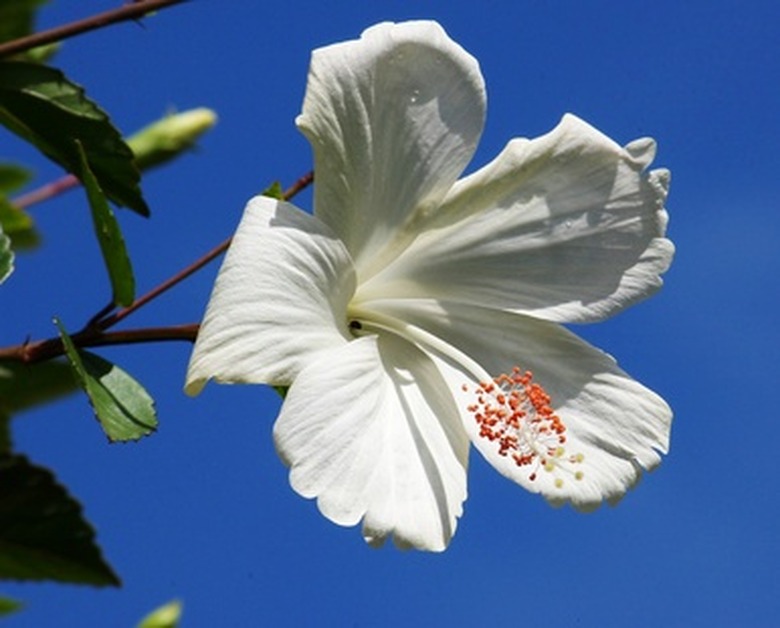White Hibiscus Flower
The hibiscus genus has claim to over 200 different species internationally. Hawaii is home to 10 species of hibiscus. Five of these species are endemic and the others are indigenous. Among them is the white hibiscus flower or white rosemallow (Hibiscus arnottianus A. Gray), which is endemic to Oahu and Molokai in Hawaii.
Names
In the Hawaiian language, the white hibiscus is "Pua aloalo." Its vernacular name is koki'o ke'oke'o ("kokio that is white like the shine of silver"). The hibiscus is a member of the Malvaceae family. "Hibiscus" derives from the Greek word for mallow.
- The hibiscus genus has claim to over 200 different species internationally.
- The hibiscus is a member of the Malvaceae family.
- "
Characteristics
The white hibiscus grows in the wild in the form of a small tree or tall shrub, often found at heights of up to 3,000 feet on the islands. It is highly fragrant. Its dainty white petals enfold a red staminal column that gives this flower its striking appearance. The contrast between the white and the red is eye-catching.
Fruit
The white hibiscus exhibits fruit that is in the shape of a capsule with brown seeds. In Kauai, another native hibiscus, koki'o 'ula'ula (Hibiscus kokio Hillebr.,) also produces a capsule with dark brown seeds, but is easy to differentiate because of its bright red petals, used to manufacture dye.
Sub-species
Hibiscus arnottianus has three sub-species. Hibiscus arnottianus arnottianus and Hibiscus a. punaluuensis grow respectively in the Waianae Range and the Koolau Range of Oahu Hibiscus a. immaculatus, classified as endangered, is from Molokai, and its existing numbers are estimated at perhaps a dozen plants.
- The white hibiscus grows in the wild in the form of a small tree or tall shrub, often found at heights of up to 3,000 feet on the islands.
- Hibiscus arnottianus arnottianus and Hibiscus a. punaluuensis grow respectively in the Waianae Range and the Koolau Range of Oahu Hibiscus a. immaculatus, classified as endangered, is from Molokai, and its existing numbers are estimated at perhaps a dozen plants.
Ancestral Role
Hibiscus arnottianus and hibiscus kokio in Hawaii are two of the eight original species of hibiscus worldwide from which all the other hibiscus flowers derive. The other ancestors are China's Hibiscus rosa-sinensis; Hibiscus lilliflorus, Hibiscus fragilis and Hibiscus genevieve from Mauritius; Hibiscus storckii from Fiji; and Hibiscus schizopetalus from Madagascar.
Botanical Name Author
"A. Gray" is the renowned American botanist, Asa Gray (1810 to 1888), who created the botanical name of the white hibiscus as well as the name Hibiscus brackenridgei A. Gray. The latter defines the yellow flowered ma`o hau hele hibiscus flower, which is the official state flower of Hawaii. Gray was a professor of natural history at Harvard University, where he organized the botany department. Among his many botanical publications is "Gray's Manual," which documents the plants of North America. He was a contemporary and friend of Sir Joseph Dalton Hooker, director of the Royal Botanical Gardens, Kew, who introduced him to Charles Darwin.
- Hibiscus arnottianus and hibiscus kokio in Hawaii are two of the eight original species of hibiscus worldwide from which all the other hibiscus flowers derive.
